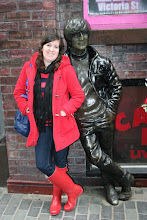I loved my visit to Oslo so much that I just had to write another blog about it. Exploring my desire to be a food journalist (combining my two great loves – eating and writing), and inspired by a birthday present from my roomie (Will Write for Food: The Complete Guide to Writing Cookbooks, Restaurant Reviews, Articles, Memoir, Fiction and More), I want to expand on the distinctive food produced in Norway and the growing reputation of Scandinavia’s hot young chefs.
Beginning in the early ‘90s, Norwegians began to take their place among the most brilliant culinary talents in Europe. The first Norwegian to win the Bocuse d’Or (known as the Concours mondial de la cuisine and frequently referred to as the culinary equivalent of the Olympic Games), was Bent Stiansen in 1993. At the time his win came as a surprise, since the gastronomy tradition of the Scandinavian countries was not as reputed as that of France or Italy. In 2011, the gold, silver and bronze prizes went to Denmark, Sweden and Norway, respectively, cementing northern Europe’s reputation as a producer of outstanding culinary talent.
Restaurants like Feinschmecker, Haga, Oscargate, Statholdergaarden, Oro Bar & Grill, and Restaurant Elk all appear in the Michelin guide today. So a country known as the birthplace of cross-country skiing, Edvard Munch and the Nobel Peace prize, is now also where gastro-enthusiasts will find some of the northern hemisphere’s most adventurous meat and fish dishes. Dried, smoked, salted and fermented, the ways that Norwegians prepare their cod, elk, lamb, trout, reindeer, ham and salmon is plentiful and adventurous.
Like its much larger neighbour to the West, Norway offers snowy mountains, rustic wilderness and a rugged coastline. And also like Canada, the Scandinavian country has a strong focus on game and fish when it comes to local produce.
To find all this produce under one roof I decided to check out Fenaknoken, a traditional food shop recently featured in Conde Nast Traveller. Walking past Oslo’s city hall, the Nobel Peace Centre and the Oslofjord, I found myself at the door of a rustic mountain cabin (or hut as the Norwegians call it) with a stuffed elk nearly licking the side of my face and wooden cross-country skis leaning against the wall. Unbeknown to me, my cousin Kirsti told owner Eirick Braek that I was a Canadian journalist, and he immediately began to pass out pieces of dried mutton, elk, reindeer, goat sausage and ham. (Unfortunately for me, Eirick was all out of bear meat.) Besides its specialties such as fenalår – a salted and cured leg of lamb that Braek held up and announced is shaped like the map of Norway – the shop sells locally produced cheeses, homemade jams (rowan berry jelly), flat bread, dried fruits, and fish of all variety. It is an absolute must-visit if you ever get to Norway.
Other fish dishes that are popular in the country are smoked salmon, dried codfish, salted stockfish, rakfish (disturbingly foul fermented trout that locals see as a delicacy), crabs, lobster and mussels. Traditional fish dishes are torsk, a poached cod served very simply with boiled potatoes and melted butter, and torsketunger, cod’s tongue. Lutefisk is another popular preparation made of stockfish (dried cod or ling) or klippfisk (dried and salted cod) that has been steeped in lye. Fiskesuppe, or fish soup, is a white, milk-based soup with vegetables like carrots, onions, potato and various kinds of fish. The Norwegians also enjoy pickled herring, or sursild, which is often served as an appetizer or on rye bread as a lunch staple.
In terms of game, Norway produces a lot of lamb, moose, reindeer, duck and fowl. Preserved meat and sausages come in a staggering variety of regional varieties, and are accompanied by sour cream dishes or crushed juniper berries on the side.
Traditional meatballs, or kjottkaker, are simpler than the Swedish variety and served in a brown sauce rather than a cream sauce. Farikal, a mutton stew, is mutton and cabbage layered in a deep pot along with black pepper, salt and some wheat flour to thicken the sauce.
Since I was only in Norway for three days I didn’t get to try even a small percentage of the exploratory cuisine that the country has to offer or eat in more than one of the dozens of restaurants that are now regularly rated among the best across Europe. Lucky for me, I have lovely and accommodating family in Norway, and loved it so much I will certainly go back, so there is plenty of time for more adventurous eating ahead.
Monday, 21 March 2011
Subscribe to:
Post Comments (Atom)


No comments:
Post a Comment